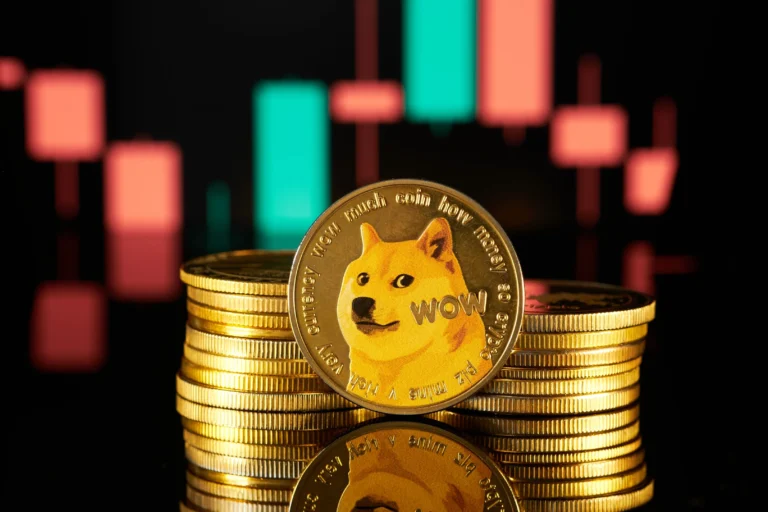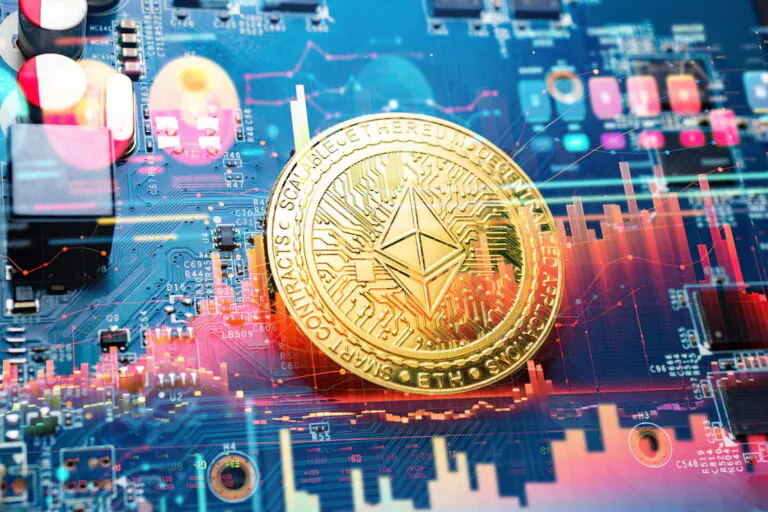Dogecoin (DOGE) with the image of a Shiba Inu dog called Kabosu as its logo, is one of the most popular and successful memecoins. It is considered an altcoin and was launched in December 2013.

What is DeFi? The principle of operation of decentralised finance, advantages and disadvantages of the project
What is DeFi?
DeFi (pronounced de-fi) or decentralised finance, decentralised finance – is a new area in the field of finance that allows participants to abandon intermediaries and make financial transactions directly with others; it is a set of services and applications that work using blockchain, cryptocurrencies, tokens and smart contracts.
In other words, decentralized finance is nothing more than an alternative to the banking system that anyone can use.
DeFi enables:
- in countries where the banking sector is poorly developed, to gain access to financial instruments;
- create a market where the government and the leaders of large financial companies will not dictate their prices for services;
- earn passively using crypto;
- significantly reduce the commission for any money transfers, deposits or loans.
Thanks to decentralized finance, you get access to your assets through secure crypto wallets, entering into smart contracts with them to make transactions. DeFi is open to everyone, all you need is an internet connection.
DeFi services tend to be faster, cheaper, and easier, with new benefits and services being offered every day.
How decentralized finance works
The whole mechanism of decentralized finance comes down to a few simple steps. Here is an example on a cryptocurrency loan project:
- First of all, you need to learn the exchange rate of the token that you would like to exchange, as well as the price of the pledge coin.
- You must pay the gross deposit amount.
- In return, you receive DeFi tokens, with the possibility of exchanging them for fiat money.
- Then there is a process of returning the taken DeFi tokens in the amount that was originally received. At the same stage, these tokens are burned.
- Collateral coins are credited to the wallet.
The easiest way to explain the above DeFi process is to use the example of a real project, namely the MakerDAO platform ($2.18 billion investment):
- The investor indicates the amount of Ethereum that he is ready to transfer to the platform as collateral. In exchange, he receives a loan of DAI (MakerDAO stablecoin) in the equivalent of ETH.
- After making a deposit, the process of transferring DAI to the wallet that was connected by the investor takes place. DAI coins can be exchanged for fiat money.
- As soon as the DAI is returned by the borrower, the token is burned, and Ethereum is returned to the wallet.
Everything is quite simple, as you can see for yourself. Here you will not be required to have any passport data or income statement, moreover, no credit history will be pulled over you.
Advantages and disadvantages of DeFi
Although DeFi is still a fairly new area in the entire infrastructure of the crypto world, requiring many improvements, but already at this stage, many of its advantages can be noted. Of course, you can’t do without negative aspects, in fact, as in any other area.
Pros:
- Decentralisation. All processes in the system are controlled not from one computer (node), but from many. In addition, these computers belong to different members of the community.
- Transparency. DeFi is developed on the basis of open source code, so the information about all transactions is in the clear and anyone can see it. Also, any developers can modify some bugs in the system if they find them and make the network as convenient as possible for their own use.
- Lack of human factor. DeFi is managed on the basis of smart contracts, which eliminates any negative human impact. Such a system works according to specific rules, they are the same for everyone. Changes to the minutes can only be made by voting.
- Inclusion. Anyone can use DeFi without first getting permission from a bank or other regulators.
- Cross-border. In the decentralized finance system, you can receive services without intermediaries. For example, here you can get a loan in just a couple of clicks, without huge interest rates and regardless of your credit history.
- Flexibility in user experience. If the user is not satisfied with the interface or functionality, he has the right to create his own. The smart contracts that power decentralized finance are like APIs that are open and for which anyone can develop applications.
- Interoperability. All new DeFi applications can be developed in combination with other decentralized finance products.
Minuses:
- Small amount of funds. If we make a comparison with ordinary monetary assets, then the volume of DeFi is quite small.
- High asset volatility. There is a lot of hype around DeFi on the market right now, because of this, the tokens of most projects are very volatile. If the value of an asset in decentralized finance falls very sharply, then the asset may be completely liquidated. For this reason, services often release more coins than planned in advance in order to cover possible loss of tokens.
- Centralized data sources (oracles). Almost all decentralized finance protocols take their data from oracles, which are controlled in one way or another by a single team. In the event that this oracle is taken over by scammers, the operation of the entire service may be disrupted.
- No real demand for DeFi services. In fact, the whole hype is not built on user demand for DeFi services, but solely on earnings from profitable farming. Thus, the rate of many services is too exaggerated and at any moment it can “burst”.
- Low system performance.One of the properties of the blockchain is its relatively slow operation. Therefore, in order to succeed with centralised finance, DeFi developers need to optimise their applications as much as possible.
- High risk of error. In fact, all responsibility when working with DeFi services falls directly on the user himself, who may be little aware of this.
- Randomness. To date, there are already many applications and finding the most profitable sometimes becomes a difficult task.
How and where is DeFi used?
Decentralized stablecoins. Stablecoins are the same cryptocurrencies as bitcoin, ethereum, dogecoin, etc., but their distinctive and most important characteristic is security in fiat currency, in another cryptocurrency, in physical assets, for example, gold, as well as in various combinations of these assets.
US dollar-backed stables, by their very nature, may require fiat collateral from a centralised source. The value of such coins is provided by the issuer, and upon application, they may be required to go through AML / KYC procedures. Due to such features of standard stablecoins, many holders' accounts were closed.
But there are DeFi stablecoins, and a good example is the MakerDAO project, which issues DAI. The issue of this token is equivalent to the issue of fiat, which is often backed by gold. But the difference is that DAI uses Ethereum.
Non-custodial landing protocols. Arguably, obtaining loans without a trusted third party or any intermediary can be called the most popular use case for decentralised finance. Non-custodial landing protocols use smart contracts to minimise risks and reduce transaction fees. Examples include: MakerDAO, Aave, Compound, Fulcrum. But Compound and Fulcrum are creating capital pools in order to help users as much as possible to narrow or borrow crypto, including DAI, USDC, ETH, etc.
Decentralised exchanges (DEXs) are blockchain-focused cryptocurrency exchanges that do not collect or store users' personal data. DEXs exempt community members from KYC. The most popular decentralised exchange right now is Uniswap.
Peer-to-peer prediction markets. Platforms that make it possible to bet on the results of games, elections, some events, etc., are called prediction markets. In many countries, such activities are prohibited, as a result of which there was an idea to make special platforms where you can bet on any of the events, court proceedings, gambling or maybe political elections.
Platforms for issuing tokenized securities (Security Token Offering). Such platforms greatly simplify, in other words decentralise, the entire process of issuing or creating securities, which is mandatory in the conventional finance sector with the participation of intermediaries. A strong argument in favor of security tokens is the division of the underlying asset into small units, making them more liquid and accessible. Examples of such platforms are Polymath, Tokeny, Harbor, and Securitize.
Asset Management. Comparing traditional assets with decentralised ones, we can say that the asset management segment of the latter is quite low. For example, there is the Melon project, with the help of which users of this project are given the opportunity to manage personal and other people's assets in the form of ETH and ERC-20 tokens. Another good example of asset management is Melon Protocol, which is controlled by the community and not by the board of directors, as is customary in traditional companies.
DeFi escrow. Escrow is a technology in which a third party is the guarantor of a transaction between two parties in escrow. For example, in this case, we can cite the Arwen project, whose users can trade on centralised exchanges, but do not place their assets there.
Synthetic assets. To date, special protocols are being created for issuing synthetic assets (a tokenized instrument that mimics the value of another asset) using smart contracts.
Investing in DeFi
A clear example of investing and answering the question of whether it is worth investing in DeFi is the fact that at the beginning of 2021, 30 billion US dollars were invested in decentralised finance, and after 10 months this figure was equal to 236 billion US dollars.
Projects in which the most assets were invested:
- Avalanche – is the largest project by capitalization. The project token, at the time of writing, is trading at $30.21, and the market capitalization is $8.17 billion.
- Uniswap – is a DEX that was created to combat illiquidity in the crypto market. At this moment, the UNI token can be exchanged at the rate of $4.92, and the market capitalization of the project is $3.54 billion.
- Chainlink – is a company that directly cooperates with SWIFT, thus gaining access to the data of those banking institutions that want to exchange information with DeFi. Today, the LINK platform token is trading at $7.01; market capitalization reached $3.24 billion.
So, you can also join the decentralised finance investor community by purchasing one of the above tokens. For example, you can exchange UNI and LINK quickly and in just a couple of clicks on the crypto exchange Coin24.io.
Prospects for the development of decentralised finance
Many experts in the cryptosphere are predicting only the big prospect of DeFi. For example, Den Simerman, head of financial relations at the IOTA Foundation, already sees huge potential in DeFi, even though they have just begun to develop. He believes that investors will soon gain strong independence and they will soon use assets in a way that seems simply unrealistic now.
Simerman believes that DeFi will soon take pride of place in the big data sector, as the main goal of their current development is to provide new options for transforming data into physical goods.
And although there are many promises from DeFi, before they will be waiting for a very long and laborious process of development and acceptance by a large society of the crypto world.
Dan Simerman summed up his statements by saying that now it is necessary not to stop and more actively conduct information campaigns with users about the potential and prospects of decentralised finance. But words will still not be enough, the community must work to implement all the goals set and attract new users precisely with the functional abilities of DeFi.
Start your crypto exchange with Coin24

Exchange BTC, ETH, USDT and more — cash or card

Secure and fast crypto exchange since 2018



